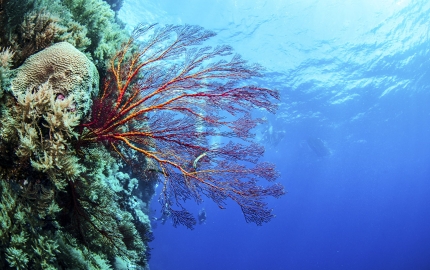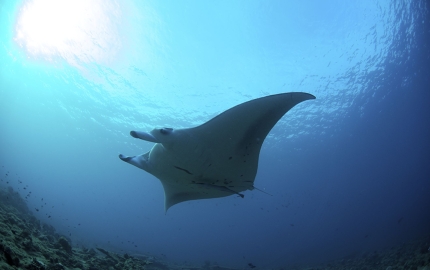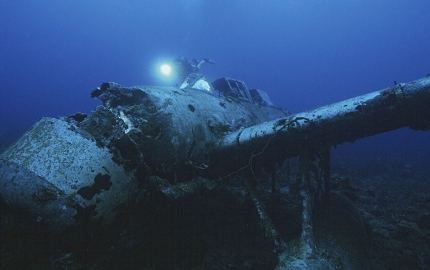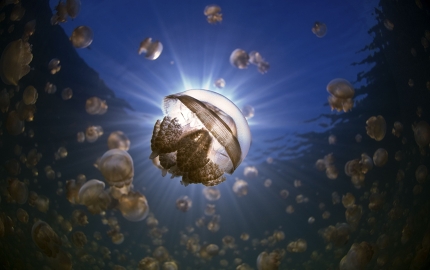Finding hidden treasures in Palau
Samantha Wilson dons her snorkel gear and slips beneath the waves in Palau, where UNESCO listed reefs, WWII wrecks and friendly jellyfish await.
I’d like to say I went to Palau for a more culturally-profound reason than the American reality show Survivor. But that’s the red-faced truth; through my television screen I had been mesmerised by the archipelago, seduced by its turquoise waters and rich marine life.
So, armed with my snorkel and fins, I set off to discover if reality really is stranger than fiction.
Floating just above the equator in the vast Pacific Ocean, Palau is a small island nation of approximately 21,000 people. The archipelago has had an eventful history; it was colonised by the Spanish, Germans and Japanese, before the Americans turned it into a military base during WWII.
My Palauan adventure begins, as it does for most, on the main island of Koror, the bustling commercial centre where many of Palau's hotels, restaurants and dive shops are concentrated; a place where Japanese influenced eateries serve food in American sized portions and where large, friendly locals delight in getting tourists to sample the regional speciality, fruit bat soup.
 Vibrant Gorgonian coral on the reefs of Palau
Vibrant Gorgonian coral on the reefs of PalauAtese / Thinkstock
While I was content soaking up Pacific life in Koror, it wasn’t until next morning, as the dive boat chugged away from the island, that I saw Palau’s true magnetism. Scything through Rock Islands South Lagoon, I marvel at the forested, limestone islands which appear to sprout up from the limpid waters like giant, green mushrooms.
Thriving reefs swirl below and amongst the coral I spot turtles, sharks and schools of fish darting through the water. On isolated islets, antiquated machines guns rust in the sea air, a haunting reminder of the ferocious WWII battles that raged on these very shores.
We arrive at the famous Blue Corner dive site where the skipper kills the engine. My dive guide, Vladimir, and I don our scuba gear and slip below the surface to explore UNESCO listed reefs considered by many to be amongst the planet’s healthiest. They are utterly mesmerising and, as I gaze at the vibrant coral shelves, I worry that nowhere else will live up to this. I might have spoilt diving forever.
 A manta ray glides through the world's first shark sanctuary
A manta ray glides through the world's first shark sanctuaryMikael Eriksson / Thinkstock
Our next dive takes us to the Ulong Channel, where strong currents whisk me through the water like a sub-aquatic waterslide, past shark cleaning stations - Palau is home to the world’s first shark sanctuary - and families of soaring manta rays.
The mood becomes more sober as I gear up to dive at Peleliu Island, where ungodly horrors unfolded amidst such natural beauty. Peleliu was the scene of the worst WWII battle in the Pacific, which claimed the lives of more than 12,000 Japanese and American soldiers.
I descend through a still lagoon and into the belly of a wrecked Japanese warship. I see where an American bomb penetrated the hull, sinking the ship and sending it to the seabed.
Dozens of wrecks remain buried in Palau’s dark lagoons; the haunting carcasses of ships, artillery and aircraft litter the seafloor. In this vast military graveyard I find a tiny fighter planes, sitting in water so shallow my diving tank is unnecessary.
From Peleliu we head to Jellyfish Lake, home to stingless jellyfish. Cut-off from the sea eons ago, these golden jellyfish lost their stings through devolution, surviving by photosynthesis in a forest-ringed lake.
 A fierce WWII battle left Palau's seafloor strewn with wrecks
A fierce WWII battle left Palau's seafloor strewn with wrecksGlobal_Pics / Thinkstock
Knowing crocodiles inhabited the islands in healthy numbers I eye the lake with trepidation and casually query Vladimir.
“Oh, there were some, but they left a few years ago,” he reassures. Yet, as I slipped into the waters and let the gentle jellyfish softly engulf me, I swear I heard him utter: “I think.”
Top five dive sites in Palau:
1) Blue Corner
Not for the inexperienced, Blue Corner is prone to unpredictable currents which attract many sharks to this dramatic ridge, which drops off into deep water.
2) Ulong Channel
Great for drift dives, simply let the current whisk you past coral shelves, manta rays and sharks in what is the world’s first shark sanctuary.
3) Turtle Wall
A favourite amongst novice divers, Turtle Wall is a shallow reef that, as the name suggests, is home to an abundance of green turtles and tropical fish.
4) Helmet Wreck
This recently discovered wreck in Malakal Harbour is easily accessed and is suitable for intermediates. A nearby reef offers a beautiful contrast to the scars of war.
5) Jellyfish Lake
Okay, so diving is forbidden in Jellyfish Lake, but you can't leave Palau without swimming amongst its famous inhabitants, which, since being cut off from the open ocean, have lost their ability to sting through devolution.
 Golden jellyfish glide through Palau's Jellyfish Lake
Golden jellyfish glide through Palau's Jellyfish Lake iSpawn / Thinkstock
Fact Box
Korean Air (www.koreanair.com) and Japan Airlines (www.jal.com) operate regular flights to Palau from Seoul and Tokyo respectively. Fish n Fins (www.fishnfins.com) have three live-aboard boats and run daily dive trips. For more information visit www.visit-palau.com.
Related articles
20 islands you never knew existed
20 wonders of the underwater world
Do you have any Feedback about this page?
© 2026 Columbus Travel Media Ltd. All rights reserved. No part of this site may be reproduced without our written permission, click here for information on Columbus Content Solutions.









 You know where
You know where